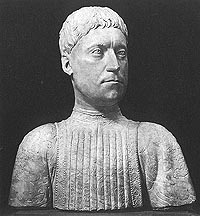steve wrote:...a lot of art "masterworks" are the product of commissions or designed to impress certain audiences, whom they service.
This is a conjecture. Some art is paid for by commission, and some particularly hollow art (Mark Kostabi's nonsense, for example, or Thomas Kinkade's) depends on an art-as-accoutrement market to exist. I contend that almost all great art is powerful because it is geniuinely, uniquely part of the artist, and is made with little consideration of its eventual audience. Some art is accidentally of interest, I suppose, but that which succeeds as intended to be great isn't ordered from a catalog.
By "masterworks" I meant that a lot of stuff commissioned by the Medicis and the Church is
a) in every standard Art History textbook
b) the realization of its purpose, its reason to be, as outlined by its commissioners (in content, theme, etc) and
c) even now put into service of history and commerce (in all their material formations - museums, tourist brochures, academia, calenders and coffee cups, etc).
I don't equate the two (craft and art), so I still don't see how art can serve anyone but the artist.
If your definition of art is that which is only made for its own sake, I don't know where you slot a Brunelleschi or Donatello. Artist or craftsman? I think the answer is both, at the same time. The distinction between an artisan (someone employed in industrial arts) and an
artist (someone working in the liberal arts) does not hold.
Others will be able to speculate on this better than I can, but it seems fair to suggest that some exceptional images and objects currently produced as commercial art will be known to future generations with the "commercial" qualification unhinged.
A textbook definition of art includes "decorative" shit like this:
(Bust of Piero de Medici, commissioned by same, by Mino da Fiesole)
You can say it's not art, but you will reduce a lot of renaissance art to "mere" craft this way. It seems anachronistic to do so.
